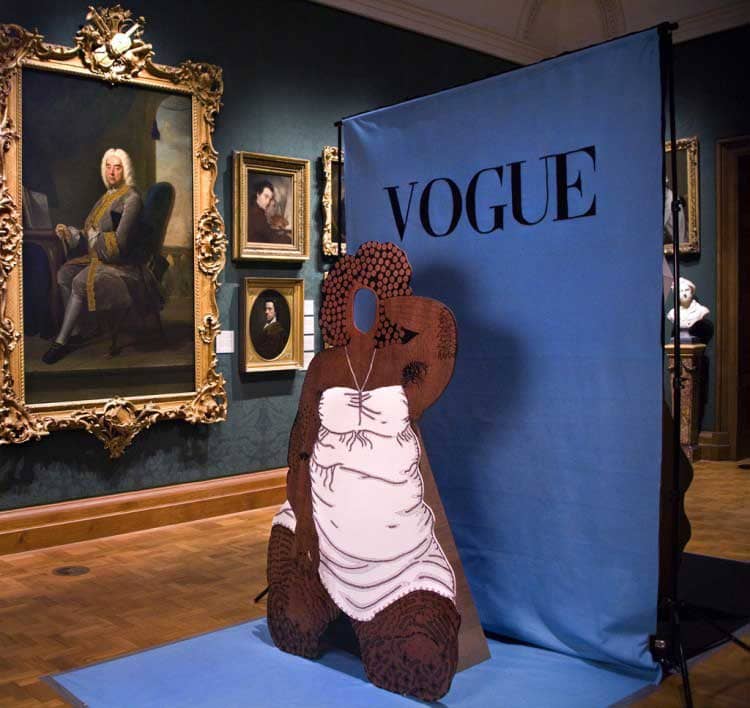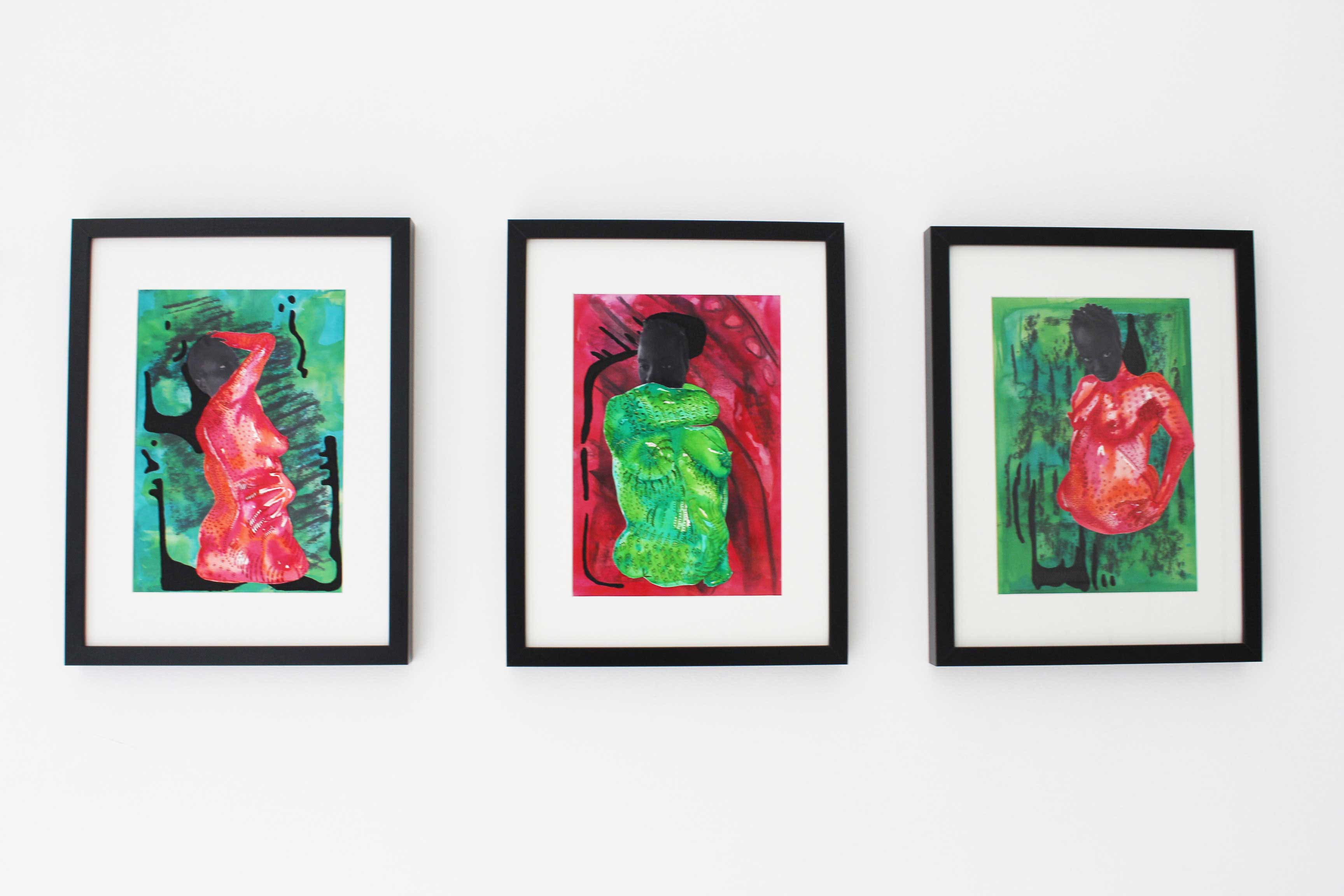From introspection, to offering an alternative to the homogeneous representation of women often seen online, Josephine Chime consistently transgresses ideas of conventional beauty, challenges the fraught history of the female nude, and creates art rooted in social commentary. Crossing the boundaries between realism and surrealism, their art regularly addresses the psychological manipulation of societal beauty standards, and works to subvert these constructs that are nurtured by the media. I recently caught up with the mixed media artist to discuss their creative practice, the power of deconstructing narratives, healing with colour, and how their Igbo ancestors and Mother Nature guide them.
NAHUEL CONTRERAS Tell me about your artist story, how were you trained? JOSEPHINE CHIME I began studying art at Central Saint Martins and did my degree in Surface Textiles for Fashion at London College of Fashion. I spent most of my college years having mini meltdowns and drawing large bodies for print design. NC How does your process change depending on the project? Tell me about your use of mixed media and how you utilise it? JC I am multi disciplinary artist so my process is fluid and inspired by different objectives. I have a studio full of diverse materials from wood, fabric, metal and plastic to assist me in my exploration in 2D and 3D worlds. NC Colour clearly has great importance in your work, how do you decide on your palette? JC I have been told that my colour choices are odd, which is good, as I like to push taste and logic. Turquoise and green are colours I often use because they remind me of nature which uplifts the soul, and is healing. NC Your work is synonymous with offering an alternative to the homogeneous representation of women often seen online. Has this always been a focus in your work? How has you art evolved throughout your career? JC Yes, offering an alternative representation of women has been my focus since creating prints for final year collection, which featured my big feet, hairy legs and large folds of skin. I’m a people watcher, and I’ve always been fascinated by what influences people’s preferences and sexual desires. I was scouring websites to find larger than life women, and came across XXL feeder sites where women present themselves in an overtly seductive manner. I came to the realisation that to really investigate my feelings of self-acceptance and attitudes towards taste, I must use my own body in my artwork.
 NC
As an artist, do you feel a responsibility for your work to deconstruct certain narratives?
JC
Yes, what is the point of experiencing the world without questioning it? I want to give people another way to look and understand what overtly or sneakily manipulates their thoughts and actions.
NC
‘Bodacious Bodies' was an art installation at the National Portrait Gallery, produced by Loren Platt and Ruby Savage, where you could be a Vogue or Playboy cover girl photographed by Nina Manandhar and Shaniqwa Jarvis. When participating in the formation of the installation, what was your objective?
JC
I created the concept, built the installation and painted the big women. I wanted to make an interactive installation for a more visceral and personal exchange with the audience, so I created Bodacious Bodies for All Walks, an art and fashion event that focused on diversifying beauty in the fashion industry.
NC
What thoughts and responses did it provoke from viewers? Is art an intervention?
JC
The response was great. My installation provoked animated conversations on why there are so many monotonous aesthetics in the media, especially women’s magazines, and how this makes us feel. The show was a celebration of rejecting societal norms, so while people waited for their photos to be printed on site, there was an instant exchange in words, a tangible media of different expectations, and a cohesive push against the sentiment that one thin, white body is the definition of beauty.
NC
As an artist, do you feel a responsibility for your work to deconstruct certain narratives?
JC
Yes, what is the point of experiencing the world without questioning it? I want to give people another way to look and understand what overtly or sneakily manipulates their thoughts and actions.
NC
‘Bodacious Bodies' was an art installation at the National Portrait Gallery, produced by Loren Platt and Ruby Savage, where you could be a Vogue or Playboy cover girl photographed by Nina Manandhar and Shaniqwa Jarvis. When participating in the formation of the installation, what was your objective?
JC
I created the concept, built the installation and painted the big women. I wanted to make an interactive installation for a more visceral and personal exchange with the audience, so I created Bodacious Bodies for All Walks, an art and fashion event that focused on diversifying beauty in the fashion industry.
NC
What thoughts and responses did it provoke from viewers? Is art an intervention?
JC
The response was great. My installation provoked animated conversations on why there are so many monotonous aesthetics in the media, especially women’s magazines, and how this makes us feel. The show was a celebration of rejecting societal norms, so while people waited for their photos to be printed on site, there was an instant exchange in words, a tangible media of different expectations, and a cohesive push against the sentiment that one thin, white body is the definition of beauty.
 NC
So much of art is the psychological relationship between the observer and the observed. As your work addresses larger social contexts, how do you balance between the eyes’ need to be visually stimulated, with expressing higher truths and evoking emotion in your viewers?
JC
My anchor is exploring a visual analysis of the onslaught of female homogeneous images, and how technology shapes desire. The automatic journey is my love of patterns and colour, so I go wherever it takes me. I have no one to answer to but myself while I paint, cut, stick, paste, shoot, and draw, so the balance between expressing high truths, and the need to make something visually stimulating, is organic.
NC
Artists often explore their own identities through their art. Is art a form of self-articulation for you?
JC
My recent work is an ongoing development of introspection, and studio experiments are a tumultuous journey in deconstructing my ego. It’s art therapy for me.
NC
How has art been a healing tool for you?
JC
Learning to love myself with all the so-called flaws that have me stumbling on the path of self-acceptance, and learning to thrive.
NC
So much of art is the psychological relationship between the observer and the observed. As your work addresses larger social contexts, how do you balance between the eyes’ need to be visually stimulated, with expressing higher truths and evoking emotion in your viewers?
JC
My anchor is exploring a visual analysis of the onslaught of female homogeneous images, and how technology shapes desire. The automatic journey is my love of patterns and colour, so I go wherever it takes me. I have no one to answer to but myself while I paint, cut, stick, paste, shoot, and draw, so the balance between expressing high truths, and the need to make something visually stimulating, is organic.
NC
Artists often explore their own identities through their art. Is art a form of self-articulation for you?
JC
My recent work is an ongoing development of introspection, and studio experiments are a tumultuous journey in deconstructing my ego. It’s art therapy for me.
NC
How has art been a healing tool for you?
JC
Learning to love myself with all the so-called flaws that have me stumbling on the path of self-acceptance, and learning to thrive.
 NC
What do you find unique about your position as a Black British artist?
JC
Us Black people we are all unique from each other, so when we form a strong, healthy alliance, it makes us powerful and unique. What is birthed from when we meaningfully connect with each other is unquantifiable.
NC
What do you find unique about your position as a Black British artist?
JC
Us Black people we are all unique from each other, so when we form a strong, healthy alliance, it makes us powerful and unique. What is birthed from when we meaningfully connect with each other is unquantifiable.No one has the same my complete vision, life experiences, strength and weaknesses, because we are not a one-dimensional monolith. I do have a heightened sense to culture vultures, where my Blackness is being used and commodified for something that has low moral value. We have to be vigilant that being Black is not packaged into a shallow product, or ideology to be sold back to us with little interest in how it impacts the Black community.
